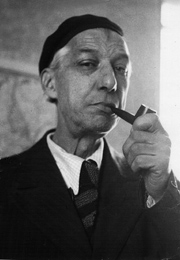Virgilio Giotti facts for kids
Quick facts for kids
Virgilio Giotti
|
|
|---|---|

Portrait of Giotti
|
|
| Born | Virgil Schönbeck 15 January 1885 Trieste, Austrian Empire (present-day Italy) |
| Died | 21 September 1957 (aged 72) Trieste, Italy |
| Occupation | Poet, short story writer |
| Nationality | Italian |
| Notable works | Lyrics and Idylls Colori |
| Notable awards | Feltrinelli Prize |
| Spouse | Nina Schekotoff (m. 1936; 3 children) |
| Signature | |
 |
|
Virgil Schönbeck (born January 15, 1885 – died September 21, 1957) was a well-known Italian poet. He used the pen name Virgilio Giotti. He wrote poems in both the Italian language and the Triestine dialect, which is a special way of speaking from his hometown.
Many people think Giotti was one of the greatest Italian poets of the 20th century. He is also considered the best poet who wrote in the Triestine dialect. His poems used the dialect to add a deeper, more personal feeling to his words. They often talked about love, family, nature, and the everyday life of his city.
Contents
Biography
Virgilio Giotti was born in Trieste on January 15, 1885. At that time, Trieste was part of the Austro-Hungarian Empire. His father, Riccardo Schönbeck, was from Bohemia and had German roots. His mother, Emilia Ghiotto, was from Venice. Giotti later chose his pen name from his mother's last name.
In 1907, Giotti and his family moved to Florence. They wanted to avoid the military draft in the Austro-Hungarian Empire. For several years, he worked as a traveling salesperson, mainly in Switzerland. In 1912, he met Nina Schekotoff, a noblewoman from Moscow. She became his partner, and they had three children: Tanda, Paolo, and Franco.
Early Works and Return to Trieste
In 1914, Giotti published his first collection of poems in Florence. It was called Little songbook in the Triestine dialect. Later, he published more works like Caprizzi, Canzonete e Stòrie in 1928, Colori in 1941, Sera in 1946, and Versi in 1953.
In May 1919, he returned to Trieste. There, he opened a small shop selling newspapers and books. He wrote many poems and some prose for various magazines. These included Solaria, Riviera Ligure, and L’Italia letteraria. He also worked as an inspector for kindergartens in Istria and the Karst region. Giotti was also a talented painter and created many drawings during this time.
His friend Roberto Bazlen introduced Giotti's work to the famous poet Eugenio Montale. Montale praised Giotti's ability to describe landscapes and observe life. He even compared him to another great poet, Salvatore Di Giacomo.
After his job as an inspector ended, Giotti worked for the city of Trieste. Later, he worked at the Maggiore Hospital in Trieste until the end of his life.
Family Life and Later Years
In the 1920s, his daughter Tanda married Emilio Quarantotto. They had a daughter named Vittorina. Giotti's son Paolo started military service in 1937. He faced difficulties during wartime but was later released.
During World War II, Giotti's sons, Paolo and Franco, went to the Eastern Front as interpreters. Sadly, both sons were captured and died in January 1943. Giotti held onto hope until January 1946, when he finally received the news of Paolo's death. Despite these great losses, he remained calm and clear-headed. He began writing a diary, which was published after his death as Appunti inutili.
Giotti was a longtime friend of Umberto Saba, another important poet. He designed a logo for Saba's bookstore. He also helped the philosopher Giorgio Fano, who married Giotti's sister Maria. Giotti and Saba's friendship changed over time, and they even avoided meeting each other in the 1930s.
Recognition and Legacy
Giotti also wrote beautiful poems in the Italian language, such as Lyrics and Idylls. In 1946, he translated a poem by the Russian poet Esenin called A Letter to Mother.
Many important critics praised Giotti's work. In 1937, Pietro Pancrazi wrote an article about him in a major newspaper, calling him one of the great poets of the century. Other famous critics like Natalino Sapegno, Cesare Segre, and Gianfranco Contini also wrote positively about him. Mario Fubini called him the greatest among poets who wrote in dialect. Pier Paolo Pasolini, another famous Italian writer, also recognized Giotti's importance in dialect poetry.
Poetry
Giotti's early poems were influenced by poets like Pascoli and Gozzano. Later, his poems became more musical. This style brought him closer to poets like Di Giacomo and some of Saba's works.
Giotti's use of the Triestine dialect was special. It felt natural but also thoughtful. Unlike other writers who focused on Trieste as a busy port, Giotti showed it as a simple place filled with feelings and people. His "Triestinity" came from using the dialect and setting his poems in the city. This created poetry with deep emotional power.
He often used a specific poem structure called a quatrain. This is a stanza with four lines. He also used a technique called enjambment. This is when a sentence or phrase continues from one line of poetry to the next without a pause. This made his poems flow in a unique way. His later poems became more like conversations and had a calm, thoughtful tone.
Works
- Piccolo canzoniere in dialetto triestino, Gonnelli, Florence 1914
- Caprizzi, Canzonete e Stòrie, Edizioni di "Solaria", Florence 1928
- Colori (silloge delle sue liriche), Florence, Parenti, 1941; Padua, Le Tre Venezie, 1943; Milan-Naples, Ricciardi, 1957; Milan, Longanesi, 1972 (con l'incorporazione delle Poesie per Carlotta, scritte nel 1949); Turin, Einaudi, 1992, a cura di Anna Modena (anche questa edizione è comprensiva delle Poesie per Carlotta)
- Sera, Edizione privata, Trieste 1946; Turin, De Silva, 1948
- Versi, Edizioni dello Zibaldone, Trieste 1953
- Appunti inutili, Edizioni dello Zibaldone, Trieste 1959
See also
 In Spanish: Virgilio Giotti para niños
In Spanish: Virgilio Giotti para niños

